
MENDOCINO & LAKE COUNTIES
Celebrating Local Food and Drink, Season by Season
edible
Volume 1, Issue 4 Summer 2024 Member of Edible Communities Summer Soups BIOCHAR: BLACK GOLD | AN ODE TO THE DINER | EDIBLE FOR KIDS



721 South State St. Ukiah 707.462.4778 ukiahcoop.com FOLLOW US ON SOCIAL Open Daily to Everyone 7am - 8pm Where Local Meets Everyday


mendocino & lake counties
PUBLISHER & MANAGING EDITOR
Karen Elowitt
DESIGNER
Cheryl Koehler
CONTACT US
To reach us by mail: Edible Mendocino & Lake Counties
705 N. State Street #191 Ukiah, CA 95482
For advertising inquiries please email: ads@ediblemendocino.com
For editorial inquiries and press releases, please email: karen@ediblemendocino.com
Every effort is made to avoid errors, misspellings, and omissions. If, however, an error comes to your attention, please accept our sincere apologies and notify us. Thank you.
No part of this publication may be used without written permission of the publisher. © 2024. All rights reserved.
Edible Mendocino & Lake Counties is published quarterly in September, December, March and June. Distribution is throughout Mendocino and Lake counties, and nationally by subscription.
Visit EdibleMendocino.com to explore our online content, subscribe to the magazine, sign up for our newsletter, find out about advertising, and much more.



What’s Cooking

A new locally produced documentary captures the stories of Anderson Valley’s founding winemakers.
6 BLACK GOLD: THE PROMISE OF BIOCHAR

This near-miraculous soil enhancer is slowly finding an audience in our region— and maybe even some local producers.
10 AN ODE TO THE DINER

17 SUMMER OF SOUP

23 EDIBLE FOR KIDS

Here’s a roundup of our favorite spots that capture the humble spirit of the diner, from Point Arena to Clearlake.
These three recipes highlight our region’s summer bounty of strawberries, pears, melons, mint, and more.
We’ve got some fun, educational activities and recipes for children, from the series Edible for Kids™ created in partnership with Barefoot Books.
EdibleMendocino.com edible mendocino & lake counties 1 4 A LABOR OF LOVE
Cover photo by FomaA
edible
First Course
I don’t need to tell you how thrilling it is to have reached the one-year mark—this is the fourth issue of Edible Mendocino & Lake Counties! Getting to this point has been a true test of stamina; like many people in our two counties, I hold down many freelance jobs, publisher and editor of this magazine being two of them. Sometimes it can get a bit overwhelming, because the magazine is basically a team of two. But it is completely worth it in the end, as it has given me the chance to learn so much about our agricultural, gastronomical and viticultural worlds, and how they intersect.
Soil is the most basic common denominator between the three. We wouldn’t have anything to grow, drink or eat without the earth that incubates the vines, seeds and roots of our mountains and valleys. Soil is a highly complex and diverse substance, and research is constantly revealing new insights into how to improve its fertility, moisture and nutrient balance. One soil amendment that holds huge promise is biochar. There are no statistics on how many farms in our area use it, but those that do are thrilled with its effect on soil health. On pages 6–9 we take a closer look at what biochar is, who is using it, and the status of efforts to produce it locally.
Soil also brings forth the summer fruits and vegetables that are the focus of the soup recipe feature on pages 17–22: strawberries, pears, melons, mint, and many others, ideally bought at our local farmers markets. I hope you enjoy making and eating them as much as I did.
Cheers to our first trip around the sun—and to many more to come!
 Karen Elowitt Publisher and Managing Editor
Karen Elowitt Publisher and Managing Editor


2 Summer 2024 | edible mendocino & lake counties


$32,500

TOTAL IN CASH PRIZES AWARDED TO MARKETS


2,435
MARKETS PARTICIPATED IN 2023

VOTE FOR YOUR FAVORITE MARKET
A Labor of Love
A new documentary captures the stories of Anderson Valley’s founding winemakers
BY KAREN ELOWITT
In mid-2020, when Anderson Valley wine pioneer Milla Handley died from complications of COVID-19, Courtney DeGraff realized that stories of the valley’s founding winemakers needed to be documented before it was too late. In 2021 and 2022 she obtained quotes to produce a regional documentary, only to learn that the project was cost-prohibitive.
“Every important wine region has a story about their appellation and how it came to be, but we just hadn’t gotten there yet,” said DeGraff, who is Executive Director of the Anderson Valley Winegrowers Association. “Then when Milla passed away I thought, ‘oh my gosh, we lost a legend, and nobody captured her story.’ I knew it was really important to do that for those still active in our community, especially since they are getting older.”
Sparked by a media roundtable discussion at Handley Cellars in 2023 that featured several of the founders, Courtney and the AVWA’s Media Relations Manager Barbara Barrielle came up with the idea to gather their stories into a documentary. Barbara had filmmaking experience and agreed to direct and produce, and they contracted local photographer/videographer Kellen Lim of Twin Giants Media to shoot and edit.
The short film, titled “Anderson Valley: A Coastal Love Affair with Wine,” was shot between October and December 2023 and focuses on the origin of the AV appellation and the stories of the figures behind it. Some of them are self-described “old hippies” who moved to the valley in their twenties as part of the “back to the land” movement of the late 60s, while others are from the second or third generation of family-owned wineries.
“It was a labor of love on a shoestring budget,” said DeGraff, who served as the film’s executive producer. “It really happened because of the dedication and passion that

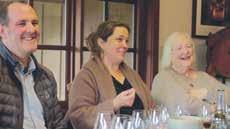
Barbara and Kellen have as filmmakers, and their love of the Anderson Valley.”
Featured winegrowers include Brad Wiley of Wiley Vineyards, Norman and Theresia Kobler of the former Lazy Creek Vineyards, Ted Bennett and Deborah Cahn of Navarro Vineyards, Zac Robinson of Husch Vineyards, Allan Green of Greenwood Ridge, and Lulu Handley of Handley Cellars.
Filming proceeded without a hitch, save for some minor hiccups, such as the time that Ted and Deborah’s dogs burst into the interview room and naturally interrupted the discussion and filming. “Kellen got so flustered,” Barbara later reported. “I thought he was going to have a heart attack!”
The film had its premiere on June 2 in the “Reel Mendo” program of the Mendocino Film Festival, and is available online to watch at youtube.com/watch?v=Fa2a25aA4WI. It will also be screened at Cinema in the Vineyards this fall.
Barielle intends to enter the film into several film festivals in 2024, which she hopes will raise the profile of Anderson Valley wines both nationally and internationally.

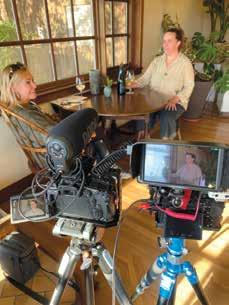
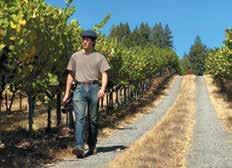
According to DeGraff, the plan is to make two more documentaries about the evolution of the Anderson Valley wine industry: one focusing on sparkling wine, and the other focusing on the rise of pinot noir. Stay tuned for more details in upcoming issues of this magazine.
4 Summer 2024 | edible mendocino & lake counties
Top photo by Sarah Wuethrich.
All others are courtesy of Twin Giants Media
For more information about Anderson Valley wines, visit youtube.com/@avwines or avwines.com.

BLACK GOLD
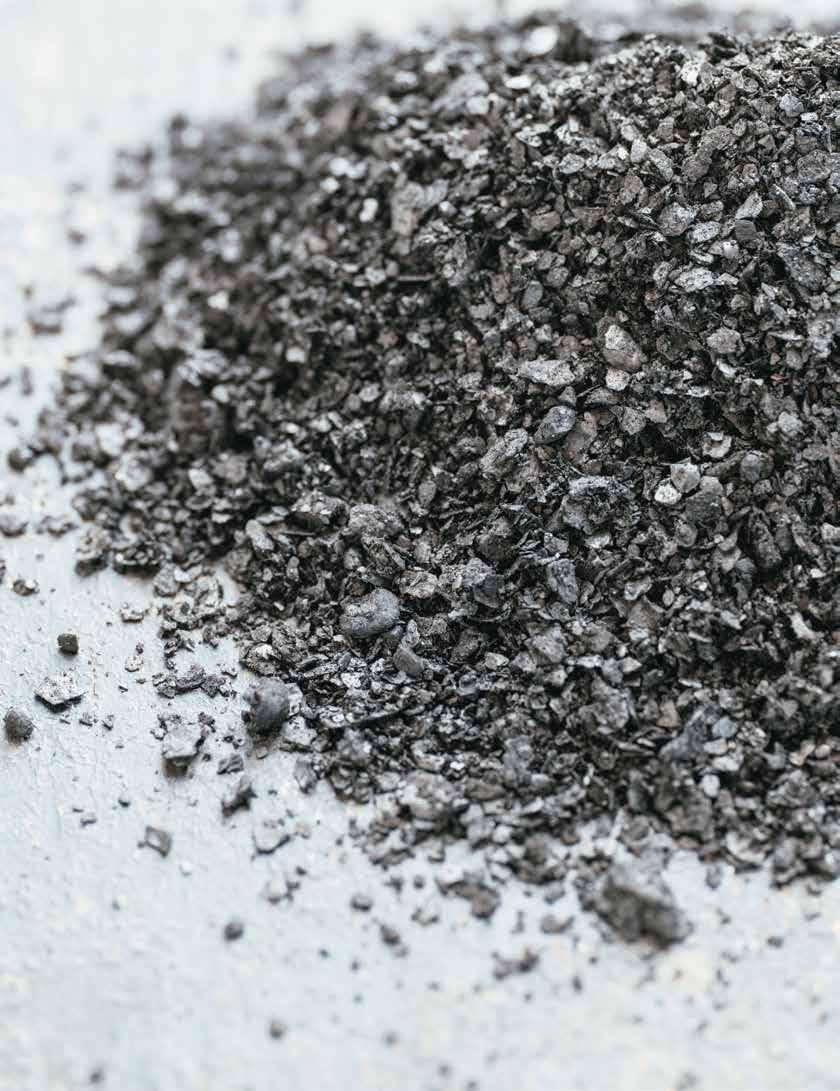
The Promise of Biochar
BY KAREN ELOWITT
6 Summer 2024 | edible mendocino & lake counties
Photo: Harald Walker/Stocksy
It may look like an ugly pile of charcoal, but it’s not—it’s biochar, a near-miraculous soil enhancer whose power is hidden in the billions of microscopic “cells” that comprise its structure. It’s slowly finding an audience with farmers in Mendocino and Lake counties, and through the combined efforts of local business leaders, researchers, and farmers, it could soon become more widely available.
But first things first—what is biochar exactly? It’s a form of pure carbon that’s made by taking biomass material such as tree branches, nut shells, and lumber waste and heating it in a temperature-controlled (350-700 degrees Celsius), low-oxygen environment for a certain amount of time. After it’s watered down and cooled, it’s crushed into small pellets, and typically mixed with compost for maximum effectiveness.
Although biochar may look like charcoal, the pyrolysis process used to create it results in a by-product that is far more porous and stable than charcoal. Which is why it’s known as “black
Biochar also has climate-change cred: It’s a fantastic sequesterer of carbon. Studies show that it can increase organic carbon in the soil by 44%-242%. It all comes back to the pyrolysis process, which is smokeless and traps carbon as the biochar forms. Creating biochar is actually the optimum way to dispose of woody organic matter, because the two alternatives—natural decomposition and burning—both release carbon into the air. Tebbutt feels that this is an important secondary benefit of biochar in this era of carbon-driven global warming.
“If you let a pile of wood chips decompose, the mycelium will eventually release the stored carbon back into the atmosphere. But if you take the same pile of wood and you turn it into biochar, the carbon is going to stick around in the soil for millennia,” he said. “Using biochar helps people be conscious of the dilemma we face, which is how to keep carbon in the ground, and out of the air.”
Biochar’s ability to improve water retention in soil also makes it a potential game-changer for farmers and the environment, especially considering the increasing intensity and length of drought periods in the western U.S. Although some farms such as Filigreen have

gold” to farmers: biochar’s millions of tiny cells act as a sponge and help soil retain water, nitrogen, nutrients, and beneficial microorganisms. And once it’s tilled into the soil, its effects last for decades, and possibly centuries, making it a near-permanent way to improve soil. In fact, there is evidence that as long as 2500 years ago biochar was used to improve the soil in the typically infertile Terra Preta region of Brazil—which still remains highly fertile today.
Studies done on soil treated with and without biochar show anywhere from a 10%-30% improved crop yield, and an average 22% increase in water retention. The figures vary depending on what material is used to make the biochar, the length and temperature of pyrolysis, the type of compost it was mixed with, local climate conditions, local soil conditions, and the size of the biochar particles. But there are very few studies that do not show an improvement to soil, and the soil we have in Lake and Mendocino counties takes very well to it.
“It’s basically a condominium for microorganisms,” said Chris Tebbutt, owner of Filigreen Farm in Boonville. Filigreen makes its own biochar from woody debris found on the farm’s 400 acres, and combines it with home-grown azolla-based compost to “inoculate” it with beneficial microorganisms and nutrients before it’s mixed into the soil. He says it works particularly well on his flowers, vegetables, and vineyard.

their own abundant water supplies, future water scarcity is a real fear for farmers who rely on rain or underground aquifers for water.
For example, in early 2024 Barra of Mendocino decided to start making biochar to supplement the soil on one of its vineyards on the eastern hills of Ukiah. According to Martha Barra, the winery’s owner, not only is the soil on the 13-acre site less fertile than that of Barra’s Redwood Valley vineyards, but the site’s well does not provide adequate water to provide full irrigation over the long term.
So far the Barra team has made two “batches” of biochar from older, less-productive cabernet and zinfandel vines that were cleared from other parts of their property to make way for new ones. After letting the uprooted vines thoroughly dry out for several weeks, they “baked” them for several hours in a four-sided, custom-made burn container under the watchful eye of Cal Fire officials. Their plan is to mix the biochar with pomace from grapes crushed at the winery last fall, and apply it this coming fall after new vines are planted on the site.
To evaluate its effectiveness, Barra said they will be testing microbial activity, carbon sequestration and water holding capacity of the soil both before applying the biochar/compost mixture, and then again next year after it’s been in the ground for several months.
“We look forward to finding the correct ratio of biochar to pomace/ compost to give us increased water holding capacity and enhance the microbiome,” Barra said.
EdibleMendocino.com edible mendocino & lake counties 7
Photos: EvaRuth (left), Jake Nash & Amy Albin (right)
EdibleMendocino.com edible mendocino & lake counties 7
A biochar-compost mixture (left); Biochar’s porous structure, as seen through an electron microscope (right).
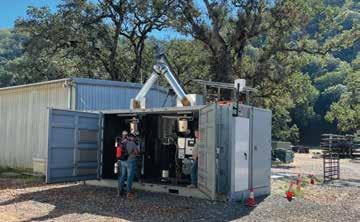

While Barra, Filigreen and other farms and wineries—such as Roederer Estate in Philo, which has been making and using biochar for the last four years—produce their own black gold, not all farms have the ability or money to do so. This potentially explains why its use is not more ubiquitous locally.
Although biochar is not terribly expensive to buy, many farms and vineyards do not have room for it in their tightly-controlled budgets. The good news is that there are grants available through various federal and state entities, such as the USDA’s Natural Resource Conservation Service (NRCS). Local organizations like the Mendocino County Resource Conservation District (MCRCD) help connect farmers with grant funds, and with educational resources.
basically any carbon-based material and break it down into two components: biochar and Syngas, the latter being primarily hydrogen, which can be burned to produce electricity. Jordan is hoping that the technology will form the basis for an energy plant that will benefit both the tribe and the environment.
“It’s basically a condominium for microorganisms”
“We’re all about helping folks expand what they’re doing on their farms, who maybe don’t have the capital to completely support it or want to learn more about it,” said Meagan Hynes, Soil and Water Project Manager at the MCRCD. “It’s a combination of administrative help and scientific advising in terms of what may be beneficial for their farm. But a big portion of what we do is to explain the whole funding process, because a lot of the applications can be complex.”
Another obstacle to adoption of biochar is availability. Those who want to use it but can’t make their own would have to buy it from outside the area, because currently there are no local producers who sell it in bulk quantities for farmers (the only northern California merchant being Pacific Biochar in Santa Rosa). But having it trucked in from other counties or states is not necessarily economically nor ecologically sensible: aside from the obvious cost of shipping, the carbon footprint of transporting biochar via diesel- or gas-powered vehicles cancels out the benefit of creating it in the first place.
But that may change in the next couple of years as local interest in biochar grows and more entities in the region explore the feasibility of production.
For the past four years Tom Jordan, CEO of the Scotts Valley Energy Corporation (SVEC) in Lake County (chartered under the Scotts Valley Band of Pomo Indians) has been investigating economic development opportunities for the tribe. In 2021 he connected with a company based in Pittsburg, CA, which has technology that generates an energy-producing material and biochar simultaneously. In a nutshell, the company’s “pyrolysis gasification units” can heat
“So you start with the material that comes from the soil, and you turn around and you put it back into the soil,” Jordan said. “The idea is to use forest material in Lake County as the input. We’re in the process of trying to establish a wood processing facility on a piece of property on Red Hills Road in Upper Lake that the tribe owns. We also have a 20-year Power Purchase Agreement established with PG&E, so we would be selling the energy back to them at a wholesale rate. As for the biochar, it could be used in a number of applications. Our primary focus is energy production and the secondary focus is the biochar, but the biochar still has a big financial component to us, so we don’t ignore it or discount it as insignificant.”
Based on the size of the plant they plan to build, Jordan estimates that they would produce about 375 metric tons of biochar per year, which equates to more than a ton per day. He said that ideally he’d like to find a local soil or compost company who would buy it wholesale, and turn it into a “ready to spread” retail product. However, it’s still early days, and he said that selling it directly to farmers is another option, if there is enough of a market for it.
“It’d be great if I could get letters of agreement from farmers who want to take it, even if it’s just small quantities, because it could add up,” he said. “And if they were local, that would be fantastic. We’re always concerned about the carbon footprint and just how far we’d have to truck this material out. After a certain distance you haven’t made a positive impact in reducing carbon.”
Jordan said that SVEC is currently seeking funding for the project, both from traditional banks, and in the form of carbon credits. He is hoping to get the plant up and running in the next two to three years.
Perhaps even more exciting is the research being done locally at the University of California Hopland Research and Extension Center (HREC). Thanks to a Cal Fire grant to the Mendocino County Resource Conservation district, HREC Director John Bailey and his team are looking at the viability of mobile technology that would be able to make biochar at its source: local forests.
8 Summer 2024 | edible mendocino & lake counties
A biogasifier unit that is being tested by researchers at UC Extension in Hopland (left). Pyrolyzed biochar cooling in a low-oxygen metal burn container at Barra of Mendocino (right).
Photo: Karen Elowitt
Photo: John Bailey
“One of the things that we have going on in our North Coast area is a lot of high fire fuel loads and excess biomass on forest lands,” Bailey said. “Right now there’s no real market for it, so government funding is the main way to pay to remove it in order to mitigate wildfire risks, and improve forest health. So potentially, biochar and related carbon sequestration credit sales could be a way to generate revenue from those fuels.”
Similar to what’s being planned at Scotts Valley Energy Corporation, the shipping container-size units that Bailey is researching would create three salable products, electricity, biochar, and carbon credits. But rather than bringing the fuel source to the machine, the machine would drive to where the fuel source already is.
“A huge cost in making biochar is transporting the biomass out of the woods, so the idea is to have these small-scale distributed units right in the forest,” Bailey explained. “You’d have a tree crew that goes out and does their work chipping wood and feeding it through, then we’d either interconnect these units to the PG&E grid and do a net metering offset or charge large-scale batteries. So you’re not transporting the biomass a long way and you’re doing more localized production.”
But Bailey acknowledges that it’s early days, and while there’s lots of promise, there are still many problems to solve. Some of the biggest are economic viability, input size, and compost timing.
“The trick is just getting the right wood chip size to produce consistent gas to run these generators,” Bailey added. “As for the biochar, we’re looking at ways to pre-treat it so that it doesn’t have the initial effect of adsorbing nutrients that are already in the soil. One of the ways that’s looking like a potential win-win is putting the biochar in
a compost pile when you first make the compost, so that it absorbs excess nutrients from the compost, not the soil. This also potentially reduces the off-gassing of nitrous oxides, ammonia and other compounds from the compost pile.”
Bailey said that his team is currently working with West Marin Compost, but he’s open to partnering with local companies such as Cold Creek Compost in Redwood Valley if and when a biochar production program becomes feasible.
As for making it all pay for itself, Bailey said that one possibility, in addition to the biochar itself and the electricity generated by the units, would be to sell carbon credits, which could prove helpful if a robust local market for biochar does not emerge.
“I think carbon sequestration credits will contribute to making distributed local biochar production more economically viable, because then you’re not limited to just selling the biochar and electricity – you can sell the credits,” Bailey added. “But that involves a very complicated process of verifying the carbon sequestration value of everything that you do, and getting layers of scientists, regulatory bodies, and market gatekeepers to sign off on it. It takes a little while, but it’s one of those behind-the-scenes things that’s necessary to make this work efficiently.”
Bailey, like Jordan, is cautiously optimistic that biochar can be locally created using this technology, but he also admits that it’s still a way off.
“It takes a little while,” Bailey said. “I’m thinking it’s probably going to be at least two to five years to get it going, and to get the market to accept it.”

BIOCHAR FOR THE HOME GARDENER
There are two ways to get biochar for your backyard garden: buy it, or make it yourself. If you don’t have the patience or skill to make your own, you can buy it online or locally. It’s typically sold in a blend that incorporates other soil enhancing elements such as compost, perlite, rock dust, coco coir, peat moss and/or humic acid. The following merchants in Lake and Mendocino counties sell either pre-packaged brands or custom-blended biochar mixes, in quantities from one-pound bags to 1.5 cubic foot buckets:
Grow West Organics, Ukiah ◆ HydroPacific Garden Supply, Ukiah ◆ Sparetime Garden Center, Willits ◆ GrowGeneration, Redwood Valley North American Organics, Redwood Valley ◆ Weathertop Nursery, Laytonville ◆ Agro Lake, Nice and Lower Lake Nottingham Nursery, Clearlake ◆ Kelseyville Lumber and Supply, Kelseyville
If you want to make your own biochar, be aware that it’s not difficult, but it’s a multi-stage process that requires an investment of time, energy, and possibly money: you have to collect some sort of biomass, pyrolyze it, then “charge” it with nutrients by combining it with compost or other materials. The pyrolysis is the tricky part—there are many ways to pyrolyze (ground pit or trench, metal bucket or barrel, homemade oven, or commercially made kiln), and which one you choose will depend on your technical abilities, budget, and personal preference. You might also need a burn permit, depending on where you live and which method you use. Many great books and internet learning resources can guide you through each step. Here are some suggestions:
◆ Gardening with Biochar: Supercharge Your Soil with Bioactivated Charcoal, by Jeff Cox
◆ Small-Scale Biochar Production, from the International Biochar Initiative biochar-international.org/wp-content/uploads/2018/04/Small_Scale_Biochar_Production_Domermuth.pdf
◆ Learning How to Make Biochar, from 5 Acres and a Dream: 5acresandadream.com/2021/11/learning-how-to-make-biochar.html
Photo: EvaRuth

An Ode to the Diner
WORDS AND IMAGES
BY KAREN ELOWITT

Why do we love diners? Is it the laminated menus, the all-day breakfast, or the worn-in counter seats where you’ll find regulars in the same spot day after day, decade after decade? Or is it the friendly staff, the quirky retro decor, or the heaping plates of biscuits and gravy? There are so many reasons to love diners, even if we can’t always agree on how to define them. Are pancakes mandatory? Is alcohol verboten? What makes a diner different from a coffee shop or a cafe? What it boils down to is what they represent: community, nostalgia, and simplicity. We’re fortunate that here in Lake and Mendocino counties we still have so many eateries that capture the spirit of the diner. Here’s a roundup of some of our favorites.





10 Summer 2024 | edible mendocino & lake counties
Jensen’s looks like a classic truck stop diner, and in fact is located adjacent to a truck repair shop. Despite the “open” sign that’s permanently affixed to the roof, Jensen’s is only open 7:00 am to 2:00 pm, and draws devoted regulars from as far as Boonville and Willits who enjoy the breakfast, lunch AND dinner items served all day.


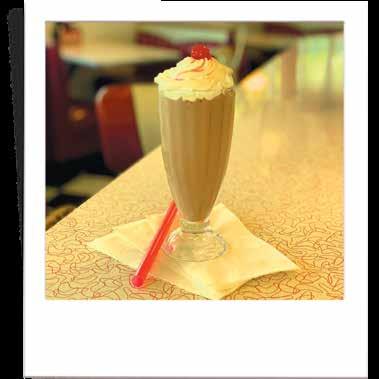
Jensen’s, Ukiah

Bebop’s Diner, Ukiah

This gas station/convenience store/ diner combo is a lone island of greasy comfort food amid Boonville’s sea of high-end farm-to-fork fare. Featuring a walk-up counter instead of table service, it’s hard to resist grabbing a gooey milkshake, juicy burger, or meaty enchilada to fill your belly after you fill up your tank.

Bebop’s is the most deliberately “retro” of all the diners on this list, and also one of the newer ones. But that doesn’t detract from its charm. Kids and families in particular love the kitschy red vinyl booths, piled-high burgers, 50 flavors of milkshakes, and monthly classic car gatherings under the neon lights.



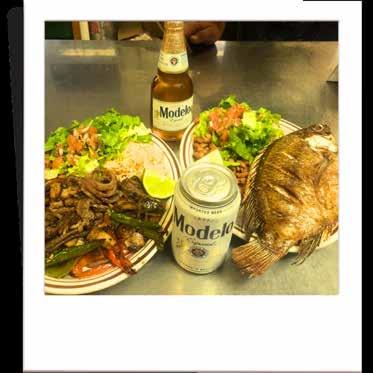 RedwoodBoonvilleDrive-In,
Courtesy: Redwood Drive-In
RedwoodBoonvilleDrive-In,
Courtesy: Redwood Drive-In
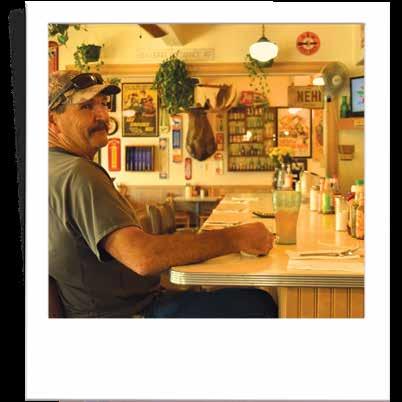


Bluebird Cafe, Hopland
Don’t let the quirky decor (most notably the giant moose head) distract you from the delicious grub at the Bluebird, which has been around for more than 70 years. Make a point to indulge in their decadent pastries (served only on weekends), plus can’t-miss items such as the blueberry blintzes, feta scramble, and juicy bison burgers.
Jason and Samantha Tocher (a former waitress at the restaurant) bought this 50+ year old Ukiah institution in early 2023, but kept it as retro as it’s always been. They appreciate their longtime regulars so much that they even named a salad after one: The Shiloh (chicken strips, bacon, avocado, jalapenos, cheese and croutons).





Forks Cafe, Ukiah


Mother-daughter team Joanne Breton and Rebecka Walters, who have owned Judy’s since 2001, keep longtime regulars happy with signature dishes such as biscuits and gravy, strawberry crepes, and shrimp po’boy. Customers are like family here—they even made a birthday cake for one of their loyal patrons when he turned 101 years old!
Judy’sUpperJunction, Lake
Over its 40-ish year history Renee’s has served generations of Lakeport residents, who return again and again to devour the creamy milkshakes, hearty burgers, and huge breakfast combos it’s known for. New owner Z, who bought the restaurant in early 2024, does plan to make some changes to the menu and decor, but he aims to retain the oldfashioned essence of Renee’s.






Owner Mike Perez moved his namesake restaurant from Lucerne to shiny new Lakeport digs in November 2023, but kept everything else the same. As the name suggests, breakfast and lunch are what you get, with menu highlights including Mike’s signature omelettes, the chicken fried steak, and the Philly cheese steak sandwich.
Mike’s Breakfast and Lunch, Lakeport

Run by Esther Rosales, matriarch of the family that also owns the nearby Rosales Market & Restaurant, Beulah’s is a tiny, cramped gem of a place where both breakfast and lunch are served all day. Don’t let the off-putting dark wood paneling and plastic chairs deter you from trying the scratch-made “garbage omelette,” the Mexican chorizo scramble, or the Beulah’s burger.



Beulah’sMiddletownKitchen,
Renee’sLakeportCafe,
Courtesy:
Mike’s Breakfast & Lunch
The massive menu at two-year-old Trejo’s has a little something for everyone: omelettes, burgers, sandwiches, fish & chips, chicken wings, steaks, pasta and more. For breakfast, the Nutella and strawberry-stuffed French toast is a winner, and if you’re into spicy, the five-alarm breakfast burrito with ghost pepper cheese and jalapenos will keep your sinuses clear.
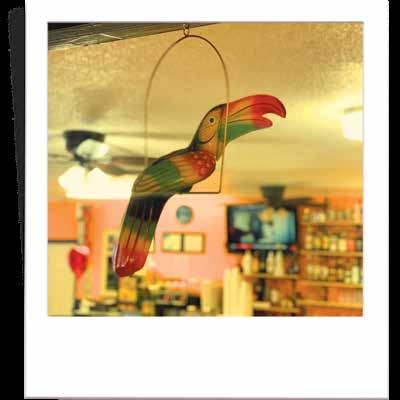


Trejo’sClearlakeDiner,

CountryClearlakeKitchen, Oaks


A diner, bar and Mexican restaurant all rolled into one, Country Kitchen is a refreshing twist on the classic diner. Breakfast is served all day and includes standards such as pancakes and biscuits and gravy. Lunch and dinner lean more towards traditional Mexican dishes such as chimichangas, burritos and spicy camarones. Diners can also enjoy local wines, and liquor from the well-stocked bar.
Family-owned (and woman-owned) for the last 18 years, this quaint cafe at the entrance to Lighthouse Pointe Resort will charm you with its striped wallpaper, antique wood stove, and breezy outdoor seating area. The menu boasts four different types of eggs Benedict plus lots of seafood choices, including fish tacos, fish & chips, and tempura prawns. Breakfast is served all day—but only on weekends.



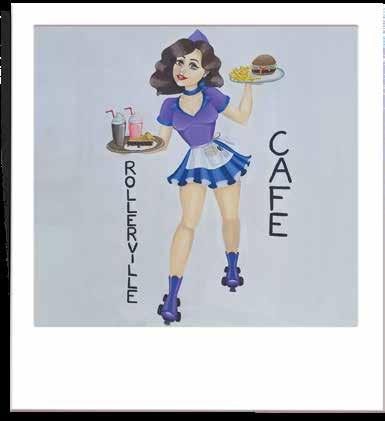 Rollerville Cafe, Point Arena
Rollerville Cafe, Point Arena


Owner Kira Klyse, who can often be found sitting alongside customers at the counter, is one of many great things about David’s. Her friendliness and effervescence complement the hearty menu, which is filled with classic American dishes, plus a few items that hint at David’s former existence as a Jewish deli, such as corned beef hash.



Home Style Cafe, Fort Bragg
Owner/chef Fortino Diaz, who renamed the former Cafe 77 for his daughter Kelly when he bought the restaurant in 2021, prides himself on making nearly everything from scratch, including customer favorites such as cherry pie, eggs Benedict, and chicken fettuccine alfredo. The lovely flower-lined outdoor patio is a perfect place to eat on a nice day.


When driving by it’s easy to miss this sign-less cafe, which sits in front of the Seabird Lodge. But you wouldn’t want to miss out on the amazing ocean views, scratch-made American and Mexican favorites, and homespun decor. Chunky chili, ⅓ pound burgers, and fresh local fish are among the favorite items.


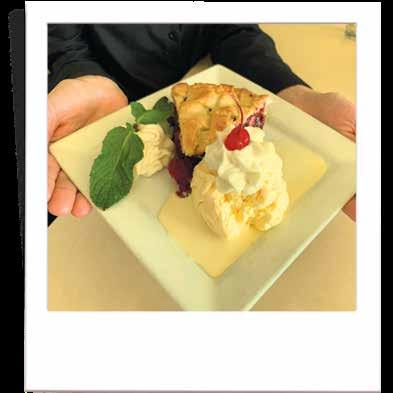
 FortDavid’s,Bragg
FortDavid’s,Bragg
Willits
Kelly’s Diner,


16 Summer 2024 | edible mendocino & lake counties

Summer of SOUP
Soup is not just for warming your innards in winter—it’s a yearround treat with flavors that flow with the seasons. Here we’ve got some delightful recipes that highlight our region’s summer bounty: strawberries, pears, melons, mint and more. A couple are cold, which can help chill you out on sweltering days, and one is hot, but all will leave you sated with the healthy goodness of summer.
Image: Adobe Stock/Erica (generated with AI)

Strawberry Gazpacho
Serves 5–6
6 large, ripe tomatoes
6 large, ripe strawberries
1 green pepper
1 cucumber
2 shallots
2 garlic cloves
2 tablespoons Sherry vinegar
½ cup extra virgin olive oil
Salt Pepper
4 small pinches of chili pepper or paprika
Crème fraîche
Sweet basil for garnish
Destem the tomatoes, then use a knife to cut a cross shape on the bottom of each one. Blanch the tomatoes for 30 to 60 seconds in a large pot of boiling water. Cool them in a large bowl of ice water for a minute or two, then remove the peels.
Destem the strawberries and slice. (Make sure to reserve some slices for garnish.)
Peel the cucumber. (You can extract the seeds with a spoon if you like.) Dice the cucumber and set aside. (Make sure to reserve some cubes for garnish.)
Cut open the green pepper, extract the seeds, dice and set aside.
Peel the garlic cloves, then cut each one in half and remove the green gem with the tip of your knife. Peel the onions and shallots. Dice and set aside.
Place the prepared tomatoes, cucumber, green pepper, shallot, onion and garlic in a blender or Vitamix together with the Sherry vinegar. Blend, adding the olive oil gradually. Blend the strawberries in last, and add salt and pepper to your taste. Blend long enough that the mixture is smooth and creamy, with no visible chunks (typically a minute or two at least).
Put the mixture in the fridge to chill for an hour or two before serving. When you’re ready to serve, portion out the gazpacho into individual bowls and add a generous dollop of crème fraîche on each one, plus a pinch of chili pepper. Chopped strawberries and diced cucumber can also be added as garnishes.
Note: For a sweeter, fruitier gazpacho, double the number of strawberries and use less tomato and green pepper.
18 Summer 2024 | edible mendocino & lake counties
Photo: FomaA




EdibleMendocino.com Nutritious, delicious, gluten-free baked goods for all! Available at various farmers markets and merchants in Mendocino, Lake and Sonoma counties. Visit mendocinobakingcompany.com to find out where to buy.

Summer Melon Soup
Any type of summer melon works for this flavorful cold soup. Look for Leopard or Crenshaw, but honeydew or cantaloupe are just as good.
Serves 3 to 4
3–4 pounds melon
½ cup Greek yogurt
¼ cup extra virgin olive oil
1 large lime, zested and juiced
3–4 mint leaves
1 teaspoon flaky sea salt
Pinch of cayenne pepper
Seed and peel the melon, then chop into medium-size chunks. Put the melon chunks, yogurt, oil, lemon zest, lime juice, mint leaves and cayenne pepper into a high-speed blender and blend until smooth (about 2 to 3 minutes). Season to taste with additional lime juice, salt and/or cayenne. If you don’t have a high-speed blender, you may need to strain the soup through a fine-mesh strainer.
Chill for at least two hours. Garnish each bowl with a mint leaf, pinch of cayenne and/or drizzle of olive oil before serving.
20 Summer 2024 | edible mendocino & lake counties
Photo: Joseph Jenkins


9550 & 9520 Main Street Upper Lake, CA
Tallman Hotel 707-275-2244 ▪ Blue Wing Saloon 707-275-2253 tallmanhotel.com | bluewingsaloon.com



EdibleMendocino.com edible mendocino & lake counties 21 BLUE WING SALOON Tallman hotel & Discover two historic treasures Beautiful Rooms
Japanese Soaking Tubs Pool ▪ Gardens Delicious Food
Live Music
▪
▪ Courtyard Dining ▪

Sweet Potato and Pear Soup
Make this hot soup when the fresh crop of summer pears comes to the market, or use canned pears instead.
Serves 5 to 6
1½ tablespoons butter
1 yellow onion, finely chopped
1½ pounds sweet potatoes or yams, peeled and diced
2 ripe pears, peeled, cored and diced (or one 15-ounce can of pears)
6 cups chicken or vegetable broth
1½ cups white wine (optional)
Greek yogurt or crème fraîche for garnish
Chopped fresh mint or parsley for garnish
Melt the butter in a large, deep pan over medium heat. Sauté onions for 2 to 3 minutes, or until softened but not brown. Add the diced sweet potato and diced pear, and sauté for 3 to 4 minutes. (If using canned pears, only sauté the diced sweet potato at this stage and add the pears later.)
Add the broth to the pot. Bring to a boil and simmer gently for 20 to 25 minutes, or until the sweet potato (and pears) are soft. If including wine in your soup, add this in the last 10 minutes simmering. Remove from heat and cool for about 30 minutes. (If using canned pears, add them now, minus the juice, which you should save. You don’t need to dice the pears, as the next step will take care of that.)
Add the mixture to a blender or food processor, and blend until smooth, about 1 to 2 minutes. (If your blender is not big enough to fit the entire batch, divide the soup into two portions and blend each separately.) Adjust the thickness and flavor of the soup to your preference by adding either more stock, more wine, more pears, or some pear juice.
Return the soup to the pan and gently reheat it, without bringing it to a boil. Ladle into bowls and swirl in some yogurt or crème fraîche. Garnish with mint or parsley.
22 Summer 2024 | edible mendocino & lake counties
Photo: Joseph Jenkins

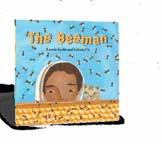
Find out where honey comes from as Grandpa the Beeman teaches the basics of beekeeping to his young grandson. barefootbooks.com/beeman
Beekeeping
Diseases and pests have killed most of the wild bees, so today, beekeepers take care of the colonies. They act as insect doctors and supply medicine to keep the colony healthy. They check on the queen to see that she is strong and that new bees are developing.
A beekeeper’s hives are the boxes where the colony lives, raises its young, and stores its honey and pollen.
Frames are man-made wooden rectangles that support the honeycomb. The honeycomb is the cluster of wax cells built onto the frames by the bees to hold eggs, larvae, pupae, honey, or pollen.
Beekeepers use a metal container called a smoker, in which they build a smoky fire. When beekeepers inspect the hive, they puff the smoke to calm the bees.
When it’s time to harvest the honey, beekeepers remove the frames from the hives and place the frames inside a large bin called an extractor. It spins the frames, and honey splashes against the walls, collecting at the bottom of the bin. Beekeepers open the extractor’s spigot and fill their jars with the tasty liquid.

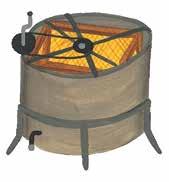
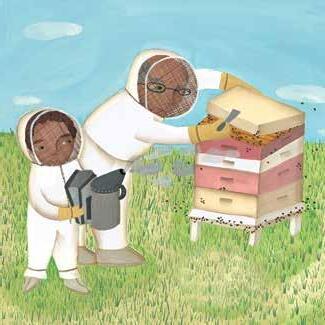
EdibleMendocino.com edible mendocino & lake counties 23 Activities, recipes, stories (and more!) created for family sharing is created in partnership with indie, award-winning, Concord, MA-based children’s publisher, Barefoot Books. Learn more by visiting www.barefootbooks.com CUT ME OUT! Learn about beekeeping!
extractor frame honeycomb
Illustrations and text adapted from The Beeman (Barefoot Books), written by Laurie Krebs and illustrated by Valeria Cis smoker hive
LET’S EAT!
Grandma’s Apple and Honey Muffins
• 2 cups sifted flour
• 3 tsp baking powder
• 1 tsp salt
• ½ tsp cinnamon
• ¼ tsp nutmeg
• 1 cup whole wheat or bran cereal flakes
• ¼ cup finely chopped walnuts (optional)
• ½ cup raisins
• 1 cup grated apple
• 2 eggs
• 2∕3 cup honey
• ½ cup milk
• ¼ cup vegetable oil

out where
from as
barefootbooks.com/beeman
Makes 18 muffins.
1. Preheat oven to 400°F.


2. In a large bowl, sift flour with baking powder, salt, and spices.
3. Add cereal, walnuts, raisins, and apple.
4. In a separate bowl, beat eggs well; add honey, milk, and oil.
5. Add egg mixture all at once to flour mixture, stirring until combined.
6. Add mixture to a greased muffin pan, filling each cup about 2∕3 full.
7. Bake for 18–20 minutes.

Are you passionate about children’s books that prioritize diversity, encourage critical thinking, and teach kids to protect the planet? Learn more about becoming a Barefoot Books Community Bookseller! Visit barefootbooks.com/cb.

24 Summer 2024 | edible mendocino & lake counties
Find
honey comes
Grandpa the Beeman teaches the basics of beekeeping to his young grandson.
Learn about beekeeping!
Recipe and illustrations adapted from The Beeman (Barefoot Books), written by Laurie Krebs and illustrated by Valeria Cis

EdibleMendocino.com edible mendocino & lake counties 25












 Karen Elowitt Publisher and Managing Editor
Karen Elowitt Publisher and Managing Editor































 RedwoodBoonvilleDrive-In,
Courtesy: Redwood Drive-In
RedwoodBoonvilleDrive-In,
Courtesy: Redwood Drive-In





















 Rollerville Cafe, Point Arena
Rollerville Cafe, Point Arena

































